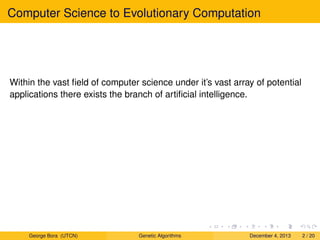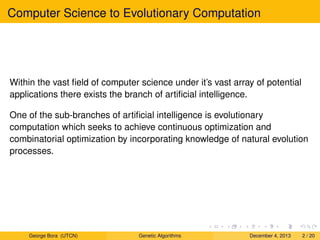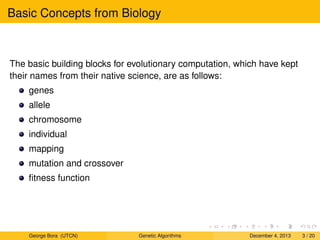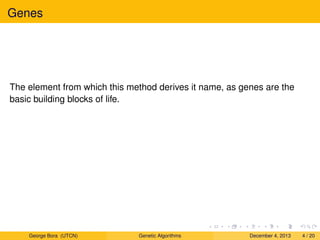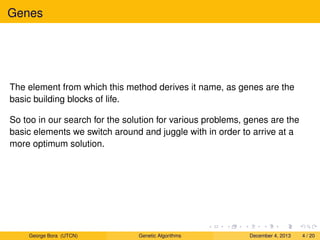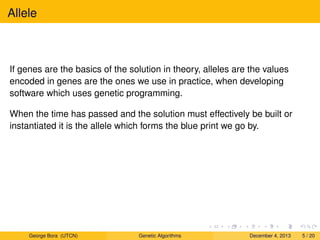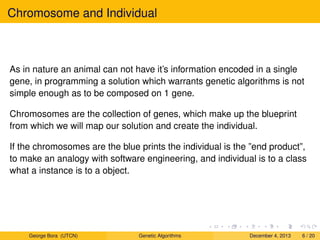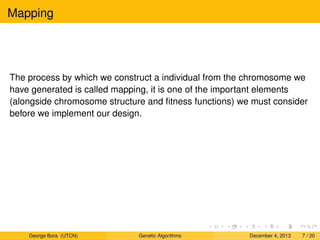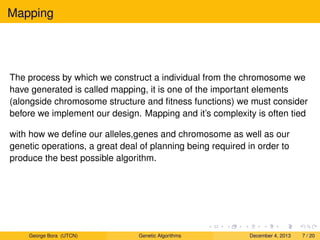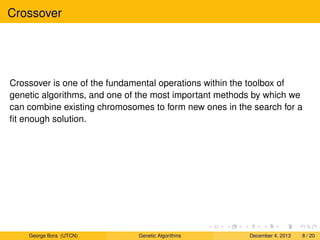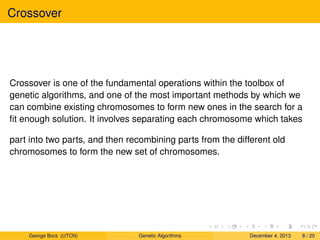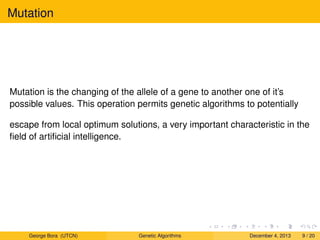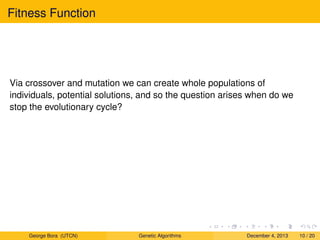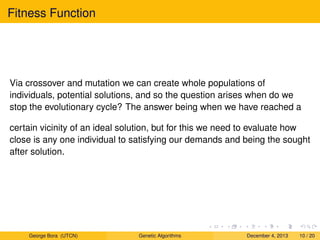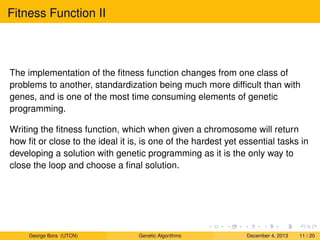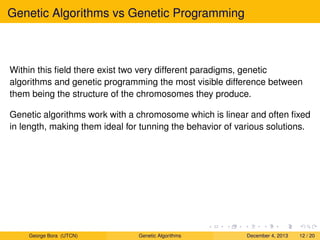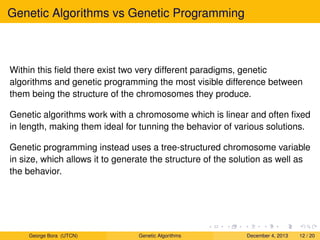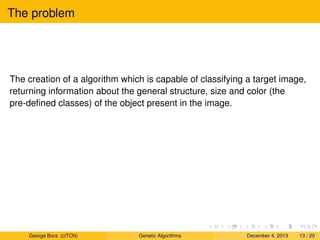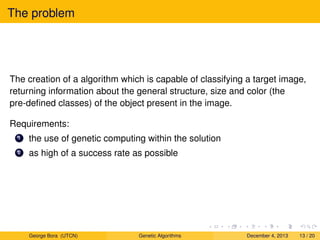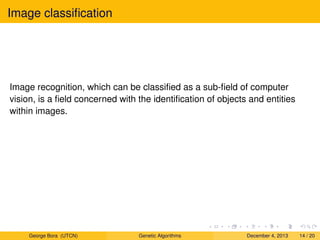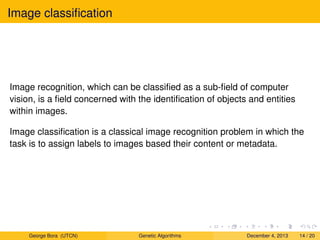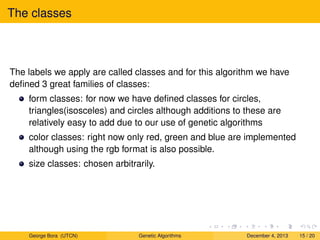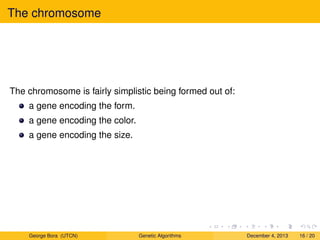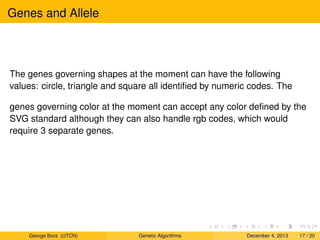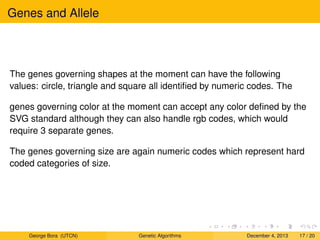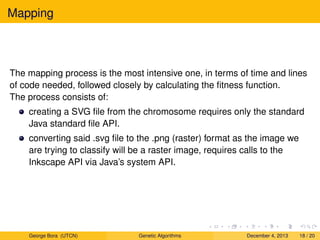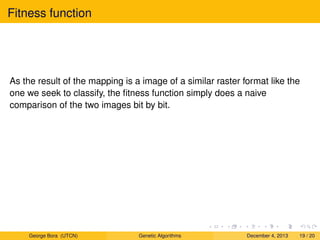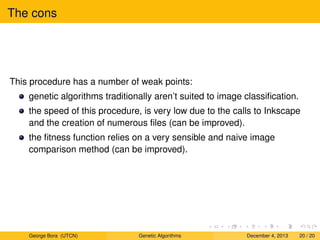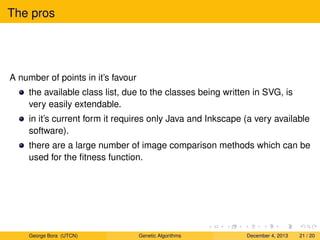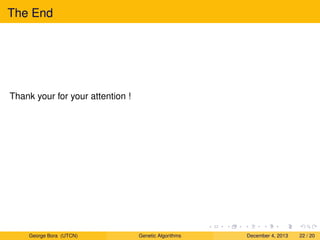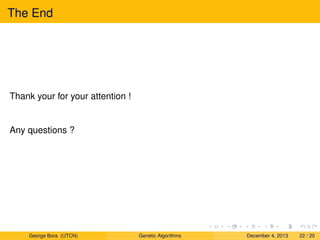Genetic Algorithms and Image Classification
- 1. Genetic Algorithms George Bora UTCN December 4, 2013 George Bora (UTCN) Genetic Algorithms December 4, 2013 1 / 20
- 2. Computer Science to Evolutionary Computation Within the vast ´¼üeld of computer science under itÔÇÖs vast array of potential applications there exists the branch of arti´¼ücial intelligence. George Bora (UTCN) Genetic Algorithms December 4, 2013 2 / 20
- 3. Computer Science to Evolutionary Computation Within the vast ´¼üeld of computer science under itÔÇÖs vast array of potential applications there exists the branch of arti´¼ücial intelligence. One of the sub-branches of arti´¼ücial intelligence is evolutionary computation which seeks to achieve continuous optimization and combinatorial optimization by incorporating knowledge of natural evolution processes. George Bora (UTCN) Genetic Algorithms December 4, 2013 2 / 20
- 4. Basic Concepts from Biology The basic building blocks for evolutionary computation, which have kept their names from their native science, are as follows: genes allele chromosome individual mapping mutation and crossover ´¼ütness function George Bora (UTCN) Genetic Algorithms December 4, 2013 3 / 20
- 5. Genes The element from which this method derives it name, as genes are the basic building blocks of life. George Bora (UTCN) Genetic Algorithms December 4, 2013 4 / 20
- 6. Genes The element from which this method derives it name, as genes are the basic building blocks of life. So too in our search for the solution for various problems, genes are the basic elements we switch around and juggle with in order to arrive at a more optimum solution. George Bora (UTCN) Genetic Algorithms December 4, 2013 4 / 20
- 7. Allele If genes are the basics of the solution in theory, alleles are the values encoded in genes are the ones we use in practice, when developing software which uses genetic programming. George Bora (UTCN) Genetic Algorithms December 4, 2013 5 / 20
- 8. Allele If genes are the basics of the solution in theory, alleles are the values encoded in genes are the ones we use in practice, when developing software which uses genetic programming. When the time has passed and the solution must effectively be built or instantiated it is the allele which forms the blue print we go by. George Bora (UTCN) Genetic Algorithms December 4, 2013 5 / 20
- 9. Allele If genes are the basics of the solution in theory, alleles are the values encoded in genes are the ones we use in practice, when developing software which uses genetic programming. When the time has passed and the solution must effectively be built or instantiated it is the allele which forms the blue print we go by. In the original vision for genetic algorithms there was only 1 allele per gene, which was a binary value and was stored in a 1 bit, as the ´¼üeld progressed all of those constrictions have been lifted. George Bora (UTCN) Genetic Algorithms December 4, 2013 5 / 20
- 10. Chromosome and Individual As in nature an animal can not have itÔÇÖs information encoded in a single gene, in programming a solution which warrants genetic algorithms is not simple enough as to be composed on 1 gene. George Bora (UTCN) Genetic Algorithms December 4, 2013 6 / 20
- 11. Chromosome and Individual As in nature an animal can not have itÔÇÖs information encoded in a single gene, in programming a solution which warrants genetic algorithms is not simple enough as to be composed on 1 gene. Chromosomes are the collection of genes, which make up the blueprint from which we will map our solution and create the individual. George Bora (UTCN) Genetic Algorithms December 4, 2013 6 / 20
- 12. Chromosome and Individual As in nature an animal can not have itÔÇÖs information encoded in a single gene, in programming a solution which warrants genetic algorithms is not simple enough as to be composed on 1 gene. Chromosomes are the collection of genes, which make up the blueprint from which we will map our solution and create the individual. If the chromosomes are the blue prints the individual is the ÔÇØend productÔÇØ, to make an analogy with software engineering, and individual is to a class what a instance is to a object. George Bora (UTCN) Genetic Algorithms December 4, 2013 6 / 20
- 13. Mapping The process by which we construct a individual from the chromosome we have generated is called mapping, it is one of the important elements (alongside chromosome structure and ´¼ütness functions) we must consider before we implement our design. George Bora (UTCN) Genetic Algorithms December 4, 2013 7 / 20
- 14. Mapping The process by which we construct a individual from the chromosome we have generated is called mapping, it is one of the important elements (alongside chromosome structure and ´¼ütness functions) we must consider before we implement our design. Mapping and itÔÇÖs complexity is often tied with how we de´¼üne our alleles,genes and chromosome as well as our genetic operations, a great deal of planning being required in order to produce the best possible algorithm. George Bora (UTCN) Genetic Algorithms December 4, 2013 7 / 20
- 15. Crossover Crossover is one of the fundamental operations within the toolbox of genetic algorithms, and one of the most important methods by which we can combine existing chromosomes to form new ones in the search for a ´¼üt enough solution. George Bora (UTCN) Genetic Algorithms December 4, 2013 8 / 20
- 16. Crossover Crossover is one of the fundamental operations within the toolbox of genetic algorithms, and one of the most important methods by which we can combine existing chromosomes to form new ones in the search for a ´¼üt enough solution. It involves separating each chromosome which takes part into two parts, and then recombining parts from the different old chromosomes to form the new set of chromosomes. George Bora (UTCN) Genetic Algorithms December 4, 2013 8 / 20
- 17. Mutation Mutation is the changing of the allele of a gene to another one of itÔÇÖs possible values. George Bora (UTCN) Genetic Algorithms December 4, 2013 9 / 20
- 18. Mutation Mutation is the changing of the allele of a gene to another one of itÔÇÖs possible values. This operation permits genetic algorithms to potentially escape from local optimum solutions, a very important characteristic in the ´¼üeld of arti´¼ücial intelligence. George Bora (UTCN) Genetic Algorithms December 4, 2013 9 / 20
- 19. Fitness Function Via crossover and mutation we can create whole populations of individuals, potential solutions, and so the question arises when do we stop the evolutionary cycle? George Bora (UTCN) Genetic Algorithms December 4, 2013 10 / 20
- 20. Fitness Function Via crossover and mutation we can create whole populations of individuals, potential solutions, and so the question arises when do we stop the evolutionary cycle? The answer being when we have reached a certain vicinity of an ideal solution, but for this we need to evaluate how close is any one individual to satisfying our demands and being the sought after solution. George Bora (UTCN) Genetic Algorithms December 4, 2013 10 / 20
- 21. Fitness Function II The implementation of the ´¼ütness function changes from one class of problems to another, standardization being much more dif´¼ücult than with genes, and is one of the most time consuming elements of genetic programming. George Bora (UTCN) Genetic Algorithms December 4, 2013 11 / 20
- 22. Fitness Function II The implementation of the ´¼ütness function changes from one class of problems to another, standardization being much more dif´¼ücult than with genes, and is one of the most time consuming elements of genetic programming. Writing the ´¼ütness function, which when given a chromosome will return how ´¼üt or close to the ideal it is, is one of the hardest yet essential tasks in developing a solution with genetic programming as it is the only way to close the loop and choose a ´¼ünal solution. George Bora (UTCN) Genetic Algorithms December 4, 2013 11 / 20
- 23. Genetic Algorithms vs Genetic Programming Within this ´¼üeld there exist two very different paradigms, genetic algorithms and genetic programming the most visible difference between them being the structure of the chromosomes they produce. George Bora (UTCN) Genetic Algorithms December 4, 2013 12 / 20
- 24. Genetic Algorithms vs Genetic Programming Within this ´¼üeld there exist two very different paradigms, genetic algorithms and genetic programming the most visible difference between them being the structure of the chromosomes they produce. Genetic algorithms work with a chromosome which is linear and often ´¼üxed in length, making them ideal for tunning the behavior of various solutions. George Bora (UTCN) Genetic Algorithms December 4, 2013 12 / 20
- 25. Genetic Algorithms vs Genetic Programming Within this ´¼üeld there exist two very different paradigms, genetic algorithms and genetic programming the most visible difference between them being the structure of the chromosomes they produce. Genetic algorithms work with a chromosome which is linear and often ´¼üxed in length, making them ideal for tunning the behavior of various solutions. Genetic programming instead uses a tree-structured chromosome variable in size, which allows it to generate the structure of the solution as well as the behavior. George Bora (UTCN) Genetic Algorithms December 4, 2013 12 / 20
- 26. The problem The creation of a algorithm which is capable of classifying a target image, returning information about the general structure, size and color (the pre-de´¼üned classes) of the object present in the image. George Bora (UTCN) Genetic Algorithms December 4, 2013 13 / 20
- 27. The problem The creation of a algorithm which is capable of classifying a target image, returning information about the general structure, size and color (the pre-de´¼üned classes) of the object present in the image. Requirements: 1 the use of genetic computing within the solution 2 as high of a success rate as possible George Bora (UTCN) Genetic Algorithms December 4, 2013 13 / 20
- 28. Image classi´¼ücation Image recognition, which can be classi´¼üed as a sub-´¼üeld of computer vision, is a ´¼üeld concerned with the identi´¼ücation of objects and entities within images. George Bora (UTCN) Genetic Algorithms December 4, 2013 14 / 20
- 29. Image classi´¼ücation Image recognition, which can be classi´¼üed as a sub-´¼üeld of computer vision, is a ´¼üeld concerned with the identi´¼ücation of objects and entities within images. Image classi´¼ücation is a classical image recognition problem in which the task is to assign labels to images based their content or metadata. George Bora (UTCN) Genetic Algorithms December 4, 2013 14 / 20
- 30. The classes The labels we apply are called classes and for this algorithm we have de´¼üned 3 great families of classes: form classes: for now we have de´¼üned classes for circles, triangles(isosceles) and circles although additions to these are relatively easy to add due to our use of genetic algorithms color classes: right now only red, green and blue are implemented although using the rgb format is also possible. size classes: chosen arbitrarily. George Bora (UTCN) Genetic Algorithms December 4, 2013 15 / 20
- 31. The chromosome The chromosome is fairly simplistic being formed out of: a gene encoding the form. a gene encoding the color. a gene encoding the size. George Bora (UTCN) Genetic Algorithms December 4, 2013 16 / 20
- 32. Genes and Allele The genes governing shapes at the moment can have the following values: circle, triangle and square all identi´¼üed by numeric codes. George Bora (UTCN) Genetic Algorithms December 4, 2013 17 / 20
- 33. Genes and Allele The genes governing shapes at the moment can have the following values: circle, triangle and square all identi´¼üed by numeric codes. The genes governing color at the moment can accept any color de´¼üned by the SVG standard although they can also handle rgb codes, which would require 3 separate genes. George Bora (UTCN) Genetic Algorithms December 4, 2013 17 / 20
- 34. Genes and Allele The genes governing shapes at the moment can have the following values: circle, triangle and square all identi´¼üed by numeric codes. The genes governing color at the moment can accept any color de´¼üned by the SVG standard although they can also handle rgb codes, which would require 3 separate genes. The genes governing size are again numeric codes which represent hard coded categories of size. George Bora (UTCN) Genetic Algorithms December 4, 2013 17 / 20
- 35. Mapping The mapping process is the most intensive one, in terms of time and lines of code needed, followed closely by calculating the ´¼ütness function. The process consists of: creating a SVG ´¼üle from the chromosome requires only the standard Java standard ´¼üle API. converting said .svg ´¼üle to the .png (raster) format as the image we are trying to classify will be a raster image, requires calls to the Inkscape API via JavaÔÇÖs system API. George Bora (UTCN) Genetic Algorithms December 4, 2013 18 / 20
- 36. Fitness function As the result of the mapping is a image of a similar raster format like the one we seek to classify, the ´¼ütness function simply does a naive comparison of the two images bit by bit. George Bora (UTCN) Genetic Algorithms December 4, 2013 19 / 20
- 37. Fitness function As the result of the mapping is a image of a similar raster format like the one we seek to classify, the ´¼ütness function simply does a naive comparison of the two images bit by bit. It then normalizes the bit difference to a range between 0 and 1, as required by the genetic algorithm, this ´¼ütness being then used in the standard manner for deciding which chromosomes pass into the next generation. George Bora (UTCN) Genetic Algorithms December 4, 2013 19 / 20
- 38. The cons This procedure has a number of weak points: genetic algorithms traditionally arenÔÇÖt suited to image classi´¼ücation. the speed of this procedure, is very low due to the calls to Inkscape and the creation of numerous ´¼üles (can be improved). the ´¼ütness function relies on a very sensible and naive image comparison method (can be improved). George Bora (UTCN) Genetic Algorithms December 4, 2013 20 / 20
- 39. The pros A number of points in itÔÇÖs favour the available class list, due to the classes being written in SVG, is very easily extendable. in itÔÇÖs current form it requires only Java and Inkscape (a very available software). there are a large number of image comparison methods which can be used for the ´¼ütness function. George Bora (UTCN) Genetic Algorithms December 4, 2013 21 / 20
- 40. The End Thank your for your attention ! George Bora (UTCN) Genetic Algorithms December 4, 2013 22 / 20
- 41. The End Thank your for your attention ! Any questions ? George Bora (UTCN) Genetic Algorithms December 4, 2013 22 / 20


